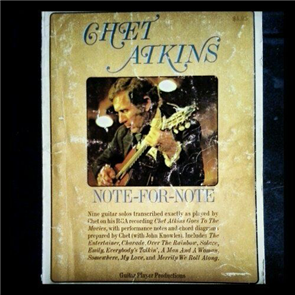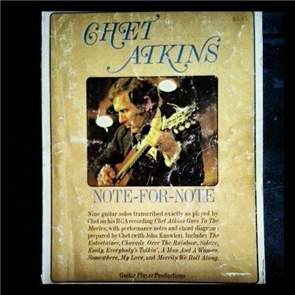Guitar by Randy Buckner
Part Two: “Chet Atkins Note-for-Note”
Tuesday, September 10, 2019 by Randy Buckner | Method Books
The Songs
Nine songs from Atkins' album, "Chet Atkins Goes to the Movies," were transcribed for this book:
"Emily" "Charade" "Solace" "The Entertainer" "A Man and a Woman" "Somewhere Over the Rainbow" "Everybody's Talkin" "Somewhere My Love" and "Merrily We Roll Along."
No Tab
When Knowles initially discussed the project with the editors at Guitar Player, the subject of tablature came up. The editors were west coast jazz guys, and they thought nobody would use tab. They didn't realize Stefan Grossman had been using it for years in his books.
As soon as Knowles realized tab wasn't going to be used - and knowing notation alone would not reveal chord shapes and positions - he decided to use chord diagrams and performance notes to explain the songs.
Knowles explained, "The analytical part of me [devised] the whole thing of numbering each line of music" to correspond with the chord diagrams. This made it easier to match a chord diagram with a specific point in the music.
Performance Notes
Knowles noticed - while teaching students a new piece of music - "over half of [the song] contained things they already knew how to do." So the idea behind the performance notes was Knowles, as the teacher, pointing out difficult passages of the music to the student via the page.
Charade
Asked which songs were the most difficult to transcribe, Knowles replied "Over the Rainbow" because of the harmonics, and "Charade" because of the flanger Atkins used on the recording.
Knowles often fields questions about "Charade." Why? Because the transcription doesn't match the recording. Well, the notes are right, the music is just out of sequence.
As Knowles explained, "I had printed some staff paper that had seven lines," and after Guitar Player received the manuscript , they cut it "to where it had the right number of lines per page." During the process of pasting the manuscript, the first two pages of "Charade" were switched.
Looking at the transcription, the first seven lines are page two, the next seven are page one, and the remaining lines are page three. So, "Charade" actually starts on the third line down on page 24, where it says 4/4.
Final Thoughts
In the world of fingerstyle guitar, "Chet Atkins Note-for-Note" is a landmark book. No book before it explained Chet's style so simply - and so detailed - that even a middle-school guitar fanatic in Springfield, Mo. could easily learn his style of playing. The songs themselves are individual lessons on how to play like Atkins.
The look of the music notation is very artistic. When Knowles said it was written in calligraphy with a fountain pen - and the aid of bottles of "White Out" - I was impressed even more.
Unfortunately, there are no plans to publish the book again. Knowles doesn't know who owns the rights.
However, Knowles has re-arranged some of the songs, and published them in his quarterly magazine. Maybe someday, whoever owns the rights will understand the goldmine they have, and publish the book for a new generation of thumbpickers to study.
Recently, as I played through the songs again - it felt as if I was meeting up with a group of old friends.
Until next time ~
Randy Buckner.
Hoover Music Co.
Springfield, Mo.
www.bucknerguitar.us
Part One: “Chet Atkins Note-for-Note”
Monday, September 9, 2019 by Randy Buckner | Method Books
When I was in middle school, I ran across an ad in Guitar Player Magazine. The advertisement was for a book of songs recorded by one of my heroes, Chet Atkins. I immediately ordered it, because the songs were transcribed from my favorite album, "Chet Atkins Goes to the Movies." Here are my thoughts on one of the most important books in my collection.
The Book
Chet Atkins Note-for-Note
By Chet Atkins and John Knowles. Copyright June 1975, by Guitar Player Productions. 72 pages. Cost of my copy: $4.95.
Cost Today
I have found examples of this book on eBay and Amazon ranging in price from $45 - $100.
What's Inside
The majority of the text was written by Knowles, with exception of the preface, which was written by Atkins. It was handwritten by Knowles, then typewritten by his wife, Becky.
Introduction
The introduction - like all the text - was originally written in first person. Knowles wrote it as if he were teaching a student how to play Atkins' music. The publishers - thinking no one knew who Knowles was - changed the text to Atkins' voice.
In the introduction, Knowles' advice to follow the score while listening to the record helped me understand the relationship between music notation and the actual performance.
Knowles suggested that when listening to the recording, listen to the melody and bass individually; identify the intro, verse, and bridge; and to listen for Atkins' articulations.
Thumb Technique
This chapter explained Atkins' thumb-work in such a way, even a self-taught middle-schooler - like me - could figure it out.
First, Knowles explained why a thumbpick was essential for the Atkins style.
He then explained the concept of a steady bass rhythm, followed by examples of Atkins' alternating bass patterns written for seven different chords. As far as I was concerned, this was the Rosetta Stone of all things Atkins.
The chapter closed with an introduction to playing the melody on top of an alternating bass. Knowles demonstrated how different melodic rhythms - quarter, half, and eighth - fit together with the bass line. Very enlightening to a beginning thumbpicker.
Anticipating the Melody
This chapter, although shorter than the rest, really summed up the Atkins style.
Knowles showed us how, while playing a song, Atkins would anticipate the melody.
In other words, picking the melody slightly ahead of the beat, thus giving Atkins' music the lilt and swing which had evaded most mortal guitarists. Again, something I had not seen in a book before buying this one.
Harmonics
This chapter tied a neat little bow around Atkins' style for me. Knowles explained not only how to play artificial harmonics, but how to combine them with a pure tone.
Because I had bought this book so early in my journey as a student, I didn't understand why others found it hard to play harmonics. Knowles explained them in such a way, it was easy to play harmonics like Atkins.
However, for Knowles, it wasn't so easy. He originally thought Atkins was playing a scale entirely of harmonics.
Knowles called Atkins, and Chet explained the technique over the phone. After a long silence, the conversation went like this: "You haven't got it yet, do you?"..."No"..."You will. Call me back when you've got it."
Knowles went to work, and figured out the technique. As we now know, Atkins would alternate a harmonic with a pure tone, creating what Knowles calls a cascade of notes.
Knowles then devised a way to write a "cue note" on the staff, to show where a harmonic occurs in the music.
My next post will be about the songs in the book.
Randy Buckner.
Hoover Music Co.
Springfield, Mo.
www.bucknerguitar.us
John Knowles: Part Three - Reflections
Sunday, September 8, 2019 by Randy Buckner | Method Books
Chet Atkins, The Person
Looking back, John Knowles remembers Chet Atkins as being a person who wanted to "get down to business."
When Atkins handed Knowles a guitar, he said, "Show me what you're working on" - meaning, "Let's get busy."
Atkins didn't want "to be on anybody's pedestal, he wanted to be a guitar player, and get to work."
But Atkins would also take time to make a five-year old feel special.
The day of the editing session, Atkins had a lunch appointment with - author and songwriter - Shel Silverstein.
When Shel arrived at Atkins' office, Knowles' son - Jay, who had been sitting quietly in Atkins' office - became very excited. Jay looked at his dad and said, "Don't you think we ought to sing one of our songs for Chet and Shel?"
Atkins and Silverstein sat back down, and listened to father and son sing. Atkins asked them to sing the song a second time, so he could record it on a portable cassette player.
Taking out a pen to write on the cassette, Atkins asked Jay the name of the song.
"The Gorilla Song," Jay said. Atkins asked if they wrote it. "Yes" Jay said. When asked if his name came first in the songwriting credits, the boy replied "yes."
Knowles said he knew Atkins was a good guy, but didn't know how deep it ran until he saw Jay being treated as a professional by his hero.
The Book
Coming from a background of classical guitar music - where students learned from printed music and teachers - Knowles "envisioned a day you could do the same with Atkins, Joe Pass, or Johnny Smith."
This led Knowles to become an early advocate for getting serious about publishing Atkins' music.
Knowles feels in the history of "how to" guitar books, "Chet Atkins Note-for-Note" was an early effort to take complex guitar music and have it "be the real thing instead of a fake approximation."
It's Affect on Guitarists
The first time Knowles heard someone play a song learned from the book, he almost went up and introduced himself. Instead, he thought, "next time...I'll do that, but this time is for me. So I kept that moment for myself. Next time...I'll ask what they learned from [the book]."
Knowles has been praised by musicians who say the book helped "decode" Atkins' music. For example, his harmonics, open string runs, and intricate scales like the one used in "Emily."
Final Thoughts
Knowles reflects, "It looked pretty nuts when I was doing the book. I was up all night transcribing, while teaching at a music store and community college during the day. I had no idea [the project] would lead where it's led."
"I just put my head down, did the work...looked up, and people all over the world wanted to know who John Knowles was because he wrote this book."
Knowles knew he was "gifted" with the opportunity to work with Atkins. He felt the obligation to "share what I had learned from that encounter."
Knowles hopes the project stands up over time. As he told me, "I felt I was given the chance to write the book I wish I could have bought when I was a kid."
Randy Buckner.
Hoover Music Co.
Springfield, Mo.
www.bucknerguitar.us




